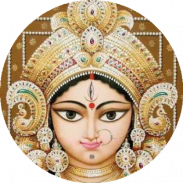




1008 Names Sri Durga श्री दुर्गा माँ के १००८ नाम

وصف لـ1008 Names Sri Durga श्री दुर्गा माँ के १००८ नाम
Durga Mantras | OFFLINE | HD Audio | Repeat | FREE | HD God image
Durga is the principal form of the Goddess, also known as Devi and Shakti in Hinduism. Durga the mahashakti, the form and formless, is the root cause of creation, preservation and annihilation. According to legend, Durga manifested herself for the slaying of the buffalo demon Mahisasura from Brahma, Vishnu, Shiva, and the lesser gods, who were otherwise powerless to overcome him. She is pure Shakti, having manifested herself within the gods so that she may fulfill the tasks of the universe via them. At times of distress, such as the mahishasura episode, to protect the universe she manifests herself via the gods.
The word Durga (दुर्गा) literally means "impassable", "inaccessible", "invincible, unassailable". It is related to the word Durg (दुर्ग) which means "fortress, something difficult to access, attain or pass". According to Monier Monier-Williams, Durga is derived from the roots dur (difficult) and gam (pass, go through).[24] According to Alain Daniélou, Durga means "beyond reach".
The word Durga, and related terms appear in the Vedic literature, such as in the Rigveda hymns 4.28, 5.34, 8.27, 8.47, 8.93 and 10.127, and in sections 10.1 and 12.4 of the Atharvaveda. A deity named Durgi appears in section 10.1.7 of the Taittiriya Aranyaka. While the Vedic literature uses the word Durga, the description therein lacks the legendary details about her that is found in later Hindu literature.
The word is also found in ancient post-Vedic Sanskrit texts such as in section 2.451 of the Mahabharata and section 4.27.16 of the Ramayana. These usages are in different contexts. For example, Durg is the name of an Asura who had become invincible to gods, and Durga is the goddess who intervenes and slays him. Durga and its derivatives are found in sections 4.1.99 and 6.3.63 of the Ashtadhyayi by Pāṇini, the ancient Sanskrit grammarian, and in the commentary of Nirukta by Yaska. Durga as a demon-slaying goddess was likely well established by the time the classic Hindu text called Devi Mahatmya was composed, which scholars variously estimate to between 400 to 600 CE.[16][17][29] The Devi Mahatmya and other mythologies describe the nature of demonic forces symbolized by Mahishasura as shape-shifting and adapting in nature, form and strategy to create difficulties and achieve their evil ends, while Durga calmly understands and counters the evil in order to achieve her solemn goals.[30][31][note 2]
There are many epithets for Durga in Shaktism and nine appellations: Skandamata, Kushmanda, Shailaputri, Kaalratri, Brahmacharini, Kaliputri, Chandraghanta and Siddhidatri. A list of 108 names that are used to describe her is very popularly in use by eastern Hindus and is called "Ashtottara Shatanamavali of Goddess Durga".
1008 Names Of Sri Durga श्री दुर्गा माँ के १००८ नाम
Om Aim Hreem Kleem Chamundaye Vichche ॐ एआईएम ह्रीं कलीम चामुण्डायै विच्चे
Durga Mantra Sarva Mangala Mangalye दुर्गा मंत्र सर्व मंगला मांगल्ये
Durga Kavach दुर्गा कवच
Durga Chandi Paath दुर्गा चंडी पाठ
Ya Devi Sarva Bhuteshu या देवी सर्व भूतेषु
Powerful Bhavani stuthi mantra पावरफुल भवानी स्तुति मंत्र
Durga Kshama Mantra दुर्गा क्षमा मंत्र
Durga Maa Aarti - Jai Ambe Gauri दुर्गा माँ आरती - जय आंबे गौरी
Durga Chalisa Namo Namo Durge दुर्गा चालीसा नमो नमो दुर्गे
Durga Dhyan Mantra दुर्गा ध्यान मंत्र
Durga maa or Durgeshwari maa is the destroyer of all evils in life.

























